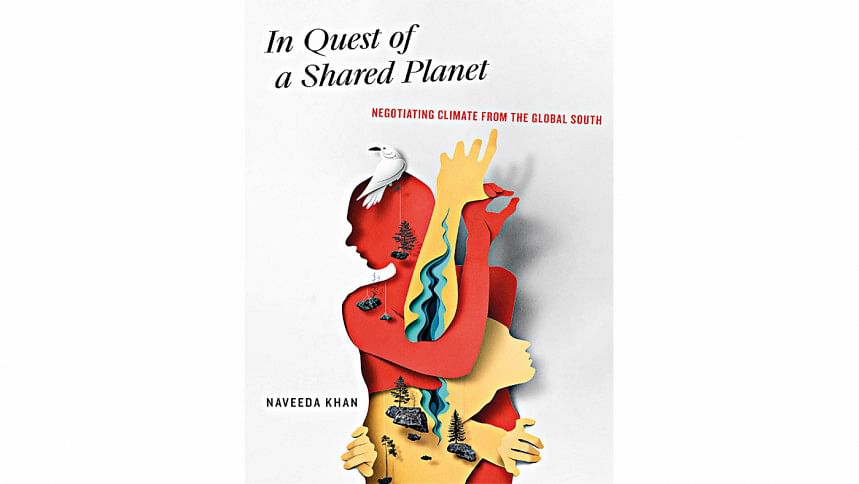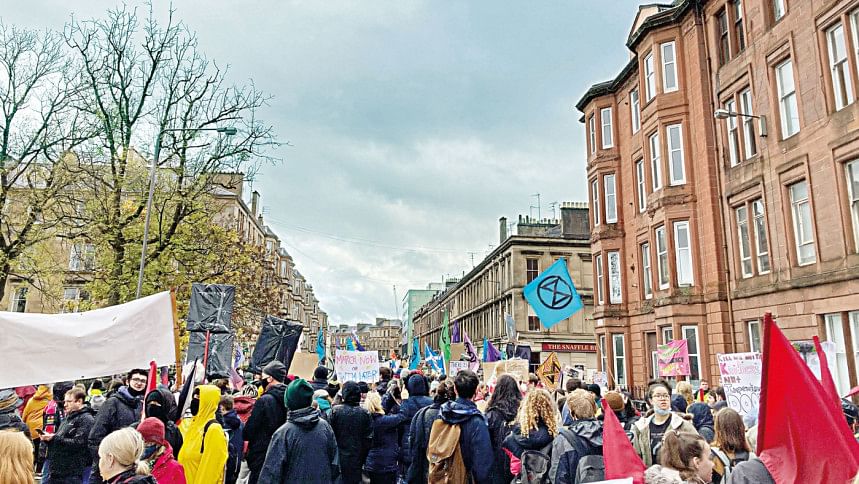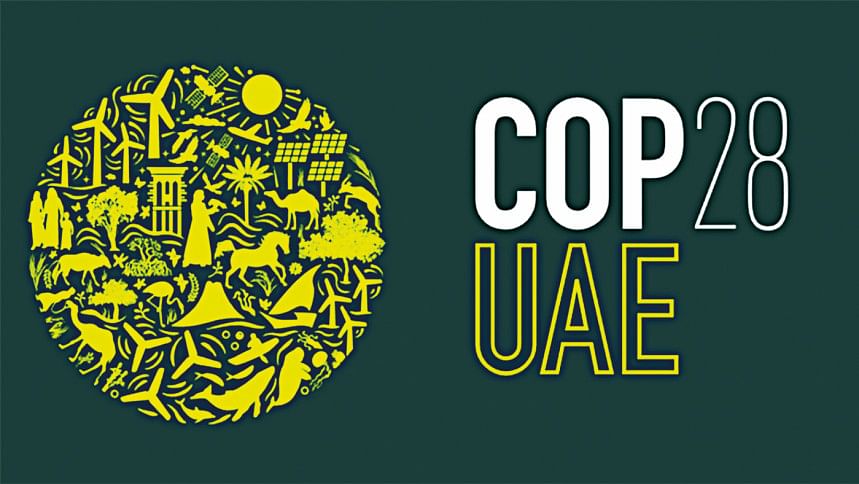We hear a lot about the COP meetings in the media. Most of what we hear is generally around the time when these meetings of high-ranking officials from most of the countries of the world are held, usually late November or early December. The next one, COP28, is going to take place in Dubai and there is already a lot of talk and even controversy around it. I recently wrote a book titled In Quest of a Shared Planet: Negotiating Climate from the Global South (Fordham Press 2023) in which I describe and analyze the U.N.-sponsored negotiations over global climate policy centering these annual Conference of Parties. It was this process that birthed the 2015 Paris Agreement and I have been observing it since that time. Of particular interest to me is why small countries, like my own, Bangladesh, attend and how they fare in the process.
Among the many questions that I have been asked while presenting my book to various audiences is, how it is that Bangladesh even came to be part of the global fight against climate change given how little it has contributed to creating the problem in the first place? Another way this question has been posed is, how did the U.S., this global superpower, and Bangladesh, labeled as among the least developed nations by the U.N., even come to be at the same table? While my book describes how Bangladesh sits at the table, that is, what kind of a "Party" it is to the United Nations Framework Convention on Climate Change (UNFCCC) and the Paris Agreement, the backstory of the two, U.S. and Bangladesh, at the table deserves telling. In this short piece, I provide a schematic sketch of U.S. involvement with climate change through several revealing books published in recent years to help us appreciate the irony of the juxtaposition of these two countries at the same table.

We have likely heard the story how the global climate did not always exist as an object of scientific inquiry. In other words, some people studied the local weather, some rainfall or ocean currents, others forestry, without much communication among them. It was only when all this heterogenous data was put together in unifying models, called Global Circulation Models (GCMs), did it become somewhat clear how the atmosphere, biosphere, cryosphere, geosphere, and hydrosphere impacted one another. In A Vast Machine: Computer Models, Climate Data, and the Politics of Global Warming (MIT Press 2013), Paul N. Edwards tells the story of how scientists, scientific institutions, citizen scientists and governments coalesced to help the wider public "see" climate, this most dispersed and abstract phenomenon, as a unified system.
The U.S. military knew of a global phenomenon called the climate system and the possibility of human induced change in the earth's climate as early as the 1950s but did not disclose it for fear of how this knowledge may be weaponized against the U.S., such as for chemical warfare. It took nonpartisan institutions, such as the WMO, another two decades to arrive at the same understanding as the U.S. military.
Edwards' story begins with the U.N.'s establishment of the World Meteorological Organization (WMO) in 1950, a non-partisan institution committed to gathering the earth's data on weather from a diversity of sources and scales. However, in The Theater of Operations: National Security Affect from the Cold War to the War on Terror (Duke 2014), Joseph Masco studies the archives of the U.S. government to show that the U.S. military knew or had at least intuited the global connections behind local weather patterns well before anyone else did, since the time of the Manhattan Project (1942-1946) set up to create a nuclear bomb. The U.S. military came to better understand such global interconnectivity through its scientific studies of soil, air, ice, space, plate tectonics, etc. all of which grew out of its interest in the radioactive fallout of its bombs (either tested within the U.S., and Pacific and South Atlantic Oceans or detonated such as in Hiroshima and Nagasaki). These bombs dispersed a specific radioactive isotope of carbon into the atmosphere, which was subsequently absorbed into the environment. Simply tracking this carbon isotope made visible the lines of connection among everything. Thus the U.S. military knew of a global phenomenon called the climate system and the possibility of human induced change in the earth's climate as early as the 1950s but did not disclose it for fear of how this knowledge may be weaponized against the U.S., such as for chemical warfare. It took nonpartisan institutions, such as the WMO, another two decades to arrive at the same understanding as the U.S. military and through using the data sets ultimately made available by the U.S. military. Masco contends that U.S. paranoia over its security won out over a broader concern for human induced ecological crises and their impact on future generations.

Fast forward to the 1970s. In a New York Times newspaper article (August 1, 2018), Nathanial Rich, journalist and author of Losing Earth: A Recent History (Picador 2020), gives a nail-biting account of how climate change was re-discovered in the U.S. in 1979, this time by U.S. civilian scientists, activists and politicians, and their decade long effort to raise this to the level of national concern so that the U.S. could decisively address, perhaps even solve the problem of climate change. Rich shows how the science of climate change, which drew on data available since 1957, was as advanced in the 1970s as today (most of the effort now is to make GCMs more accurate in their simulations of past, present and future climate scenarios). What became finally evident at this moment was the connection between the well-known greenhouse effect by which the atmosphere absorbs and traps the sun's heat, human consumption of fossil fuels increasing carbon content within the atmosphere, thus increasing its heat trapping potential, and subsequent increased warming leading to anthropogenic or human induced environmental change, with the earth's climate system distributing environmental harms across the globe. Rich's account shows how invested all parties, including Republican politicians and fossil fuel companies, were in understanding the mechanisms behind climate change and trying to think of practical ways of combatting it. This non-partisan engagement with climate change continued until the U.S. government lost its political will to lead this fight in 1989, retreating behind the position that the science was not yet decisive about human links to the climate to justify immediate action, that time would tell what needed to be done. And so it was that the climate became a politicized issue in the U.S, that of "radical environmentalists," Democrats and progressives. In contrast, the Republican Party became a party of majority climate change deniers and fossil fuel industries became major exponents of disinformation.
Facts usually lose their power to shock upon constant repetition, but I have found that the facts about Bangladesh do not. They seem to grow more terrifying as I come to understand the climate system and the impacts, possible irreversibility, and scale of climate change.
It was another few years before the U.N. process, initiated by WMO and the United Nations Environment Program (UNEP) would finally catch up to the knowledge and action already initiated and aborted in the U.S by 1989. The 1992 Rio Conference laid the grounds for the current U.N. sponsored negotiations over global climate policy through the drafting and ratification of the United Nations Framework Convention on Climate Change. The UNFCCC set in motion the annual COPs at which countries that had signed on to the UNFCCC would draft policy applicable to all, with some carve outs or flexibilities for least developed countries and small island nations.

It is in Rio that U.S. and Bangladesh came to be at the same table and the terms were set for their mutual engagement with climate change. In The Compromise of Liberal Environmentalism (Columbia 2001), Steven Bernstein provides a scholarly account of the 1992 Rio Convention (also the 1992 United Nations Conference on Environment and Development). He shows how the U.S. came to the meeting having already decided that they would not take the leadership on this issue because of the constraints it would place on exploiting their own resources (especially coal) and the potential curbs on their economic competitiveness in a world with emerging economic powers, such as Brazil, China and India. Therefore, the rhetorical push from the start was to make anthropogenic climate change not as a problem created and therefore to be dealt by historically industrialized countries. Rather it was packaged as a global problem, "unknowingly" initiated by industrialized countries. Industrialized countries would take the lead in making changes to their economy to mitigate the problem but only because they were further along the development spectrum. Moreover, they would only do so provided they were soon joined in their efforts by industrializing countries that were on the path to being more carbon emitting than older industrialized ones. Meanwhile, small, poor and vulnerable countries were to be encouraged to do what they could in terms of reporting and perhaps reducing their carbon emissions. This understanding of climate change as a global problem set in motion a process by which industrialized countries, such as the U.S., stalled and continue to stall on meaningful progress, while pushing for industrializing countries to take on equal burdens of mitigation, and while industrializing countries stall pointing out that they need to emit carbon to reach a certain level of development before they can join the fight.
Meanwhile, countries such as Bangladesh, which do not have the same expectations placed on them in terms of mitigating, religiously attend the COPs. This is what drew me to the meetings in the first place. Why did Bangladesh attend a meeting which largely looked to be a long standing spat between developed and developing countries, between older industrialized and newly industrializing countries? Some reasons are obvious. It's the job of those working in the climate cell of the Ministry of Environment, Forestry and Climate Change to go and they do the country credit with their knowledgeable and skillful negotiating across a wide range of issues. The COP meeting is also a rich site for networking and forging mutually beneficial relations with other countries, public and private corporations, even international activist movements. Other reasons, while also seemingly obvious, are more heart-wrenching. There are video images and descriptive captions accompanying Nathaniel Rich's New York Times article mentioned above. They bear grim witness to the changes fast upon us. As expected, a flooded Southern Bangladesh is among the images. The caption notes that the monsoons are intensifying due to the rising temperature of the earth's atmosphere. The water surface of the Bay of Bengal is also much hotter than usual. Just those two facts alone mean a deluge of rains and a sharp rise of sea level water, by almost five feet, which together could produce the displacement of 50 million people of the country. When I first heard these facts, they had an unreal air about them, indicating that it was hard for my mind to wrap itself around them. Facts usually lose their power to shock upon constant repetition, but I have found that these facts about Bangladesh do not. They seem to grow more terrifying as I come to understand the climate system and the impacts, possible irreversibility, and scale of climate change (I recommend seeing Ai Weiwei's 2017 film Human Flow on the global refugee crisis to get a visual sense, or rather shock, at what 50 million displaced people looks like). As I explore in my book, In Quest of a Shared Planet, Bangladesh sends its officials, civil society members, and media to keep its eye on a process that may be the country's only hope of a collective, global solution to its coming problems, be it through more honest and ambitious mitigation efforts of industrialized and industrializing countries or through radical adaptation, which may even mean mass migration. Bangladesh's presence at the COPs may be taken to be a kind of anxious, prodding vigilance of the process. Let us hope that our faith in multilateral environmental agreements, such as the UNFCCC and Paris Agreement, in international meetings and processes, such as the COPs, and, in humanity's will and ability to face down such an extreme challenge, are not misplaced.
Naveeda Khan, Associate Professor and Chair, Anthropology, Johns Hopkins University
(Her recently published book In Quest of a Shared Planet is available for buying, and free download here: https://research.library.fordham.edu/literary/2/ and in amazon.com)


Comments